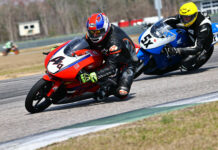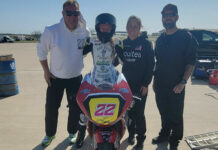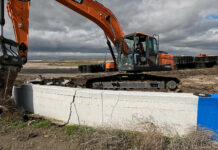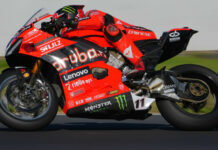A release from MS Aprilia Racing Press Information, in which Melandri takes back his bike-and-team-bashing comments again, Laconi talks about the RS Cube and certain details of aerodynamic development are revealed:
Tuesday, 28 May 2002
PREVIEW
Italian Grand Prix, Mugello. Fifth round of the World Championship
Built in 1974, the Mugello International Racetrack hosted the first motorcycling Grand Prix in 1976. A modern, technical circuit with some unique features: there are fast curves followed by tight corners which are difficult to negotiate, and the track rises and falls continuously against the splendid backdrop of the hills of Tuscany. In the long final straight, which rises slightly towards the end, extraordinary speeds can be attained. Owned by Ferrari, which has made it the #1 circuit for F1, Mugello also boasts some exceptional characteristics for the Grand Prix. So it is hardly surprising that Aprilia should use it as its competition-bike test bed. The most recent of all, the RS Cube, has spent part of its adolescence right here. Mugello is the venue for the Italian Grand Prix and is thus a very important event for both riders and manufacturers. The hills around the circuit will be filled with fans of the great World Championship stars. In terms of colour, sound and “warmth”, it may well be considered as the most important event of the entire championship.
The circuit: 5,245 metres – left curves: 6 – right curves: 9 – longest straight: 1,141 metres – Maximum width: 14 metres – Year of construction: 1974.
2001 winners. 125 Class: Ueda (Jap) Honda – 250 Class: Harada (Jap) Aprilia – 500 Class: Barros (Bra) Honda.
Circuit records. 125: Locatelli 2’00.029 (2000) – 250: Nakano 1’54.462 (2000) – 500: Doohan 1’53,342 (1998).
Marco Melandri – 250cc Class – Aprilia RSW 250
Last week, Marco Melandri was called to the Racing Department of Noale for a meeting with Ing. Witteveen to clear up some misunderstandings which had cast a shadow over events at Le Mans. At the race in France, Marco had made some rather critical comments about the technicians and the company, expressing his unease in a harsh and impulsive manner. Last week’s meeting, however, cleared matters up and Marco expressed his regret for what had happened, pointing out that he had lost none of his esteem for his colleagues. He also had first-hand experience of the total commitment of the Racing Department to the 250 world championship in which he, Marco, is the lead player.
“The Le Mans race was very difficult in a number of ways: too many words, not enough understanding. I certainly didn’t mean to talk ill of those who work with me, and I’m very sorry about everything that happened. I’d like to thank them for the work they do with such dedication, for they give much more than 100% to give me a true competitive edge. When I’m out on the track, I represent them and the entire team. I just hope I’ve got their esteem once again and regained the feeling we’ve always had. They too are real enthusiasts: they believe in what they’re doing and they’re a family for me. At least, they sure are when I’m out racing. I still need to have a different frame and that’s what I asked for, because the one I’ve used so far doesn’t give me all the confidence I need. I’ll be able to try out a couple of solutions to find out which is best suited to my needs. Mugello is a really tough track, one of the most technical in the MotoGP, where the difference comes out in the most crucial sections: the Casanova, the Savelli, and the two Arrabbiate. That’s where you’ve got to be really competitive. We’ll see what the weather gets up to: Mugello normally requires pretty hard tyres but a lot depends on what the weather’s doing. I’ve got a few hours to relax now so I can reach Mugello with a clear mind so I’ll be all ready to take on the most important race of the year.
REGIS LACONI – MotoGP – Aprilia RS3
Back from a very important rendezvous – his “home” race in the French Grand Prix – Régis is now coming up to another key moment in this year’s championship: the Italian Grand Prix. Considering his dual nationality, he is getting ready for his second “home” race of the year. There is thus a dual responsibility, with both Régis and Aprilia racing an “Italian” race: but, of course, this is also where the RS Cube has clocked up many of the kilometres it has covered in its brief life. Both bike and rider know this track very well, so it should not present all the surprises that some of the other world championship circuits hold in store for the four-stroke from Noale when it comes on to them for the very first time – making the work really hard for all those involved. In the pause between the race in France and the Italian Grand Prix, no tests have been carried out, so Régis has been able to take a rest after the considerable pressure he was put under during the Le Mans weekend. In France, Laconi made ninth place – the RS Cube’s best placing so far on a dry track – and he was particularly pleased with this result, as he was with the ovation he received from the French public on his return from the GP. A few day’s rest in his chalet in the Swiss Alps and today he starts getting ready for the race at Mugello: two 50-kilometre rides on his racing bicycle and then into the gym where he will be working with his athletics trainer to build up his stamina.
“A few days’ rest has got me back on board: I was as much physically tired as nervously exhausted. It’s normal, really, at these important events where you’re so emotionally involved. Sure, I know I’ll be in for the same sort of pressure during the race in Italy – which is, after all, my second country – as well as being Aprilia’s home ground. We know all the ins and outs of the track and we’ve been round it lots of times, even though never in ideal weather conditions: there’s often been strong wind or driving rain, but it’s certainly where the RS Cube really started to take off. Mugello is where we’ve got the most information and data about how the bike behaves. We’re going to do our best, so we’ll immediately try to find the best set-up of the bike in the first test sessions on Friday. I’ll be talking things over with the technicians, but I think that for the very first sorties we’ll be using different set-ups so we can work out the best solutions. We’ll be concentrating on the choice of tyres, as the track is much more abrasive than the one we were on in the last race in France. I love this track – it’s extraordinarily technical and fast, and the two corners, Arrabbiata 1 and 2, have no equal the world over. This is where I want to get a great result. We need it – the time has indeed come.
TECHNICAL BRIEFS:
The Aerodynamics of the RS3

Aprilia has always paid careful attention to the aerodynamic characteristics of its products, continually investing in research and development.
The aerodynamics of the RS3 was designed entirely within the Aprilia racing department, and heavily relied on the experience gathered during the years of racing motorbikes at the highest level, and the recent developments in aerodynamic analysis.
Within the motorsports industry aerodynamic analysis is undergoing continual development; where the main limitation lies within the competition rules and regulations, not to mention budget restrictions (unlike F1).
Currently the importance of the aerodynamics of racing motorbikes is inferior than in F1, due to the fact that the effect it has on the chronometer (lap time) is inferior. However, with further development this could quickly change.
Within the Aprilia Racing Department the aerodynamic development is concentrated in;
· the reduction of the drag coefficient, lift coefficient and pitching moments.
· the minimisation of the effect of lateral wind
· the optimisation between aerodynamics and motorcycle dynamics.
Aprilia uses different tools to development the aerodynamics of its motorbikes, these include;
· wind tunnel testing
· aerodynamic computer simulations (CFD)
· track tests.
All three methods described above are of vital importance for a rapid and correct aerodynamic application to a new project.
The most recent tool introduced in the aerodynamic analysis of racing motorbikes is computer simulations (a virtual wind tunnel). These simulations produce a multitude of data and information (pressure and velocity distribution, aerodynamic forces, flow lines, etc.) that is immediately accessible for consultation; this data constitutes a base for the initial definition of the aerodynamic project and for further development.
The progressive and continual evolving of the hardware and software tools used for computational simulations enables this analytical method the become more efficient and more effective.
Since Aprilia has set itself the objective to continually develop winning products, the company keeps a vigilant eye on the continual evolving of new technologies for aerodynamic development, evermore important within the motorcycle racing industry and always applicable to production bikes.






